Mike | Living with HCM
Montville, New Jersey | Born 1960
I don’t know what a normal heart feels like, all I know is what I have.
Mike and Gianna glide down the sunbaked track outside the high school in Montville, NJ, which provides the familiar backdrop as they catch up on each other’s lives. Gianna just finished her sophomore year at college, and in less than a week, she’ll start an internship in Buffalo, NY, many hours away. It will be some time until the two get to work out together again. With enthusiasm, they share stories from their lives—Gianna’s semester and nostalgia for home, Mike’s chiropractic practice and engagement to his fiancé, their favorite sports teams.
Now a collegiate field hockey goalie, Gianna aims to stay in shape this summer. Her dedication undoubtedly stems from her father. As a former wrestler, bodybuilder, professional chiropractor, and lifelong athlete, Mike has taken a disciplined approach maintaining his physique. The hours at the gym and jogging are integral parts of his week, scheduled around appointments with clients and other obligations. Exercise and training provide him with a sense of progression, of purpose, and come with the imperfect promise of longevity.
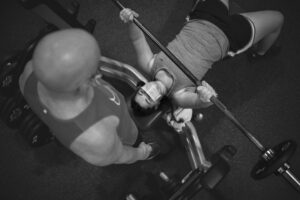
At the gym, Mike spots Gianna at the bench press as she does her reps. She completes ten steady presses before Mike helps guide the bar back onto the rack. He throws her a quick high-five and picks up a dumbbell from the floor. “I don’t do the bench press anymore,” he explains as he repeats some curls. “I can’t risk my defibrillator going off on me then.” Just below his left shoulder lies the life-saving device, which has shocked him a total of six times since it was placed in 2005, potentially saving his life each time.
Below Mike and Gianna’s fit exteriors exists a complex tale of negotiating life with an unseen burden. They both carry a mutation of the myosin-binding protein C gene (MYBPC3) which provides the instructions for developing heart muscles. For Mike, this genotype developed into hypertrophic cardiomyopathy (HCM), a genetic heart condition where a thickening of tissue hinders proper blood flow, potentially causing a host of cardiac events including sudden cardiac arrest (SCA). The autosomal dominant condition has been passed down through generations in Mike’s family, leaving an indelible imprint on their physical and mental health.
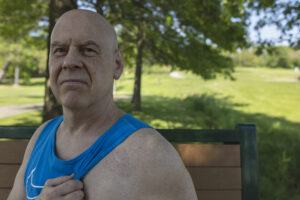
There are also the scars, now dulled by the passing of time though still visible if you’re looking for them. Most notably, one runs the vertical length of Mike’s sternum—this from a septal myectomy, an operation that has allowed him to live a busy life with a serious heart condition. He also has three just below his left shoulder where his defibrillator was placed (followed by two subsequent battery replacements.) “In today’s age of Game of Thrones, the scars I have are like being through a war,” says Mike. “I don’t know what a normal heart feels like, all I know is what I have. I know that I get out of breath, I know that it beats hard, and I now know that I have limitations. I have to watch what I do.”
Mike walks the line between staying in peak physical shape while not overexerting himself. He and Gianna have both had to change their habits, and their mindsets to remain active and not overstress their heart muscle. “It’s tricky for me,” says Gianna. “I don’t know when and if I’ll ever experience symptoms.” The uncertainties play a significant role in Gianna’s life—HCM will always affect her mentally. However, armed with the right attitude and a better understanding of HCM, she and Mike are pushing to make the best of their situations.
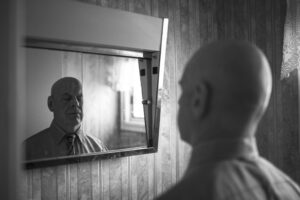
Born in New Jersey, the first of seven brothers, Mike is not the type of person who likes to lose. “One of my many flaws is that I’m a very competitive person,” he says. He attributes much of his voracity to his father, John. “My father was the toughest man I ever met,” says Mike. “Not just physically, but mentally.” Throughout his youth, his father demanded diligence and follow-through from his children. “Each morning we had to have our homework outside our door and our shoes polished,” recalls Mike. “I learned to tie a tie very early in life. I wore it every day to grammar school.” His father’s strictness instilled a desire to get better at whatever Mike did. Little did he know then, but under the stern exterior, there was also constriction—the walls of his father’s heart were starting to thicken, causing bouts of dizziness and a lack of endurance. John never spoke of it. Meanwhile, his children tried to remain on his good side and stay out of trouble.
His mother, Marge, had an incredible decade of reproduction, giving birth to eight straight boys in the 1960s (only to lose one right after birth). Evan was the third eldest but usually the last to get picked when the brothers divided up with other neighborhood kids to play a game of football or baseball. However, his consistent low draft selection had little to do with his hand-eye coordination. At 10, during a routine checkup, Evan’s doctor discovered a heart murmur. Following the unusual news, each of the brothers had to get an echocardiogram to test the rhythm and strength of their heart. “They heard the murmur in me too,” says Mike. However, being otherwise healthy and young, there was no major reason for concern—Evan just couldn’t exert himself too hard. “We would put him on first base or something… We didn’t think much of it. Our understanding was that he would live a normal life.”
Mike, on the other hand, excelled at pushing himself physically. After being cajoled by his father, he took up wrestling in seventh grade. “At first, I wanted no part of it,” he recalls. “I was terrible.” After failing to win a single match that first season, he didn’t lose once the following. As he began to advance as a wrestler, he adopted many of the associated habits—precise training regimens, and close observation of his weight.
One day during eighth-grade Spanish class, Mike received a note telling him not to stay after school for wrestling practice. During his next break between classes, he went to check his weight in the locker room. To his surprise, his father was there, visually emotional. “We lost Evan,” he said. Mike didn’t understand, though his father offered no further explanation at the time.
Evan, 13 at the time, had been out at recess bouncing a basketball when suddenly his heart stopped. He fell to the asphalt and became unresponsive. A classmate rushed over and attempted CPR while his teachers called 911.
The ambulance arrived with Marge in tow. She followed the EMTs into the back of the ambulance with her son inside. They continued CPR, but Evan’s heart would not restart. It was 1975, and external defibrillators were not widely available to EMTs. By the time they made it to the hospital, Evan’s heart had stopped for long enough to end his life.
“We lost Evan,” his father repeated.
Mike still didn’t grasp the gravity of the situation. He followed John out to the family’s checkered station wagon filled with the rest of his family. Everyone was sobbing. For Mike, it was all too incredible to come to terms with the fact that his younger brother had died. It wasn’t until the next morning, at breakfast, that the loss finally registered. “I remember flipping pancakes for my brothers. I looked at his seat and said, ‘Where’s Evan?’” In the silence that followed, the realization dawned on him.
“To this day, a number of Evan’s classmates have a meetup to catch up and remember him,” says Mike. The person who performed CPR on Evan still lives locally. “Not long ago he came up to me, and just said, ‘I tried.’” He remembers his brother fondly, and as Evan’s loss shook the family, for Mike, the necessity to stop future tragedy became readily apparent.
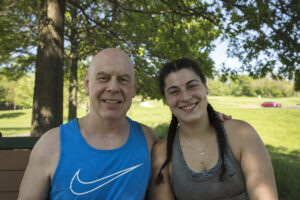
A career chiropractor with a specialty in sports medicine, Mike has been helping alleviate the pains and injuries of his patients for over 35 years. In 2015, he was awarded New Jersey’s Sports Chiropractor of the Year, recognizing his contributions to the field and his deep understanding of athletes’ needs. His career has provided him a stable income, from which he was able to start a family.
However, as Mike approached his 40s, this stability would be challenged by increasing HCM symptoms. Not long after Gianna was born, Mike sat in a rocking chair holding her in his arms when he suddenly felt a rushing in his chest. “It scared the crap out of me,” he relays. Lasting only 30 seconds, this first episode was the start of real HCM symptoms for Mike. “I thought, I’d better get it checked out,” he remembers. “It wasn’t real until that point.”
It soon became clear that Mike would need to see a specialist—someone well-versed in HCM—to get the help he needed. He ended up going to his father’s doctor who told Mike that his cardiomyopathy had become obstructive—the walls of his heart had become so thick that blood could not flow properly. Furthermore, Mike learned that as his heart beat faster, even less blood was continuing to circulate.
Mike reached out to family for advice, specifically his father. “My father never talked about his HCM unless I asked him,” he recalls. As Mike experienced new symptoms, he learned that his father too, dealt with many of the same issues, including frequent light-headedness when standing up or stepping out of the shower. The news was not comforting.

A few years later, more serious symptoms started to arise. One day, Mike was carrying six-year-old Gianna into her bedroom for a nap, when he suddenly lost consciousness. He collapsed right in front of her bed, sending her fortunately bouncing onto the mattress. Mike was suffering ventricular tachycardia (VT). As his heart continued to race uncontrollably, Gianna’s mother called an ambulance and Mike was sent to the hospital where he recovered.
In the next year, more monotonous activities posed a challenge due to Mike’s HCM—the simplest tasks at work suddenly became unimaginably difficult. His body was sluggish; he was consistently out of breath. He struggled to maintain consciousness while seeing patients or performing other duties at work. Even walking to the bank to make a deposit was now a laborious mission. “At 45 years old, I was basically useless.”
Mike turned to others for help. He connected with the Hypertrophic Cardiomyopathy Association (HCMA) where he learned about new options for treatment. In 2005, he had a defibrillator implanted. Then, in 2007, he decided to get a septal myectomy in hopes of unobstructing his heart. The surgery removes the extraneous muscle mass from the septum of the heart, restoring the ventricles’ ability to move blood. “I was hoping it was going to be a one and done thing,” says Mike. In December of 2007, over the Christmas holiday, Mike traveled to the Cleveland Clinic to get surgery. “Cleveland Clinic is like the Disneyland of the medical world,” Mike says laughing. The surgery proved to be transformational, and within days he began noticing results. “It was a game changer,” he says. “A life saver.”
While Mike was given back a functioning heart, his complications were far from through. In 2013, he was doing an incline bench press when he felt his heart flutter and then a piercing shock. “I dropped the weights and said a few choice words. Everyone in the gym was looking at me.” His defibrillator had gone off. “My doctor told me, it probably saved my life,” says Mike, shaking his head. In 2017, Mike again suffered from VT and ended up in the hospital. In total, his defibrillator has shocked him six times.
In contrast, in all his years, Mike’s father was only shocked once, although he did suffer from atrial fibrillation, which Mike has not. In 2016, his father passed away from a stroke at the age of 82. No other of Mike’s brothers or their many children have had symptoms from HCM. Despite imploring them at times, none of them have found the need to get tested, something Mike can’t quite understand.
Never one to play the HCM card for pity, Mike views his condition as difficult, but manageable based on his attitude, his naturally competitive nature, and his ability to easily access care. “This condition has really ruined a lot of other people’s lives,” he admits. Needless to say, he feels lucky, and continually pushes the boundaries of what is possible.
“I was considering getting back into bodybuilding again,” he casually mentions. Pushing through has always been Mike’s style. It stems from the same drive that drove the teenage wrestler to get into bodybuilding in the first place. This endurance has allowed him to overcome many of the obstacles that HCM has thrown in his path. “HCM doesn’t run my life,” he says defiantly. “I don’t hold back on anything.” In turn, he attempts to teach Gianna the same attitude and good habits to allow her to thrive.
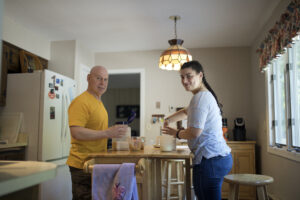
Gianna listens to her father retell his story, nodding and reflecting to herself. At 8 years old, she found out she had the MYBPC3 variation (mutation), and began coping with what this would mean for the rest of her life. “I remember when I turned 13, I breathed a big sigh of relief,” she says. Knowing what befell Evan has informed Gianna in not pushing her luck too far either. She plays goalie in field hockey, a position that while stressful, doesn’t require miles of running. She avoids overconsumption of salty foods and caffeine, which her other friends at college, “basically live on.”
“When I was younger, I was restricted in gym class,” Gianna remembers. “I wouldn’t run the mile with my friends or do anything like that. Honestly, I wasn’t complaining about it. I didn’t know the gravity of it.”
Mike felt the gravity day one after Gianna received her genetic test results. “I cried for hours,” he says. He felt awful passing a specific burden to someone he loved dearly. However, so far Gianna’s heart has tested normally. “It’s just a question of whether it’s going to thicken or not,” adds Mike. His experiences, however difficult, have been passed down to Gianna as critical information, the closest thing to a roadmap for how to navigate a variable, unpredictable disease. For Mike and Gianna, HCM is something they share as both a burden and a bond. “I’m still learning a lot about it,” says Gianna. “I think everyone is, because there’s new things coming out all of the time.”
Gianna laughs as the two get out the ingredients for a batch of cupcakes. They return to conversation and occasionally sing along with their favorite pop diva as she blares through the speakers. “So you were never a saint and I loved in shades of wrong / We learn to live with the pain, mosaic broken hearts.” “They call me the Swifty-over-fifty,” says Mike with a twinkle in his eye. He and Gianna laugh together, and in moments like this they forget the troubles that HCM has and could cause in their lives. Sometimes living in the moment is the best medicine.
